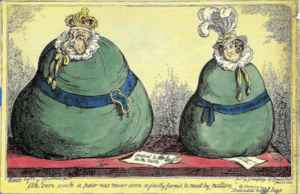I had worked on George Cruikshank with Emma. We found that he was a well known satirist that focused on sociopolitical topics such as slavery and temperance. He had a caricaturist style and used etching and woodcuts to create his works. Most of his works poked fun at the royal family and other political figures. After class I did some more research to see if he ever got in trouble for these works, and I found that he was not formally prosecuted for his satirical illustrations of the royal family, but he did received a substantial bribe from King George IV to stop caricaturing him. he took the bribe, but didn’t fully keep up his end of the bargain. 

-
Recent Posts
Recent Comments
- wcturgeon on Commericials and Fairy Tale memes
- Alyssa Masino on Commericials and Fairy Tale memes
- Connor Scott on Commericials and Fairy Tale memes
- Erik Kubelka on Commericials and Fairy Tale memes
- Emma Gallagher on Commericials and Fairy Tale memes
Categories
Meta

Ivan Bilibin was born in St. Petersburg in 1876 and went to art school in 1895. In 1899 he received an order for an art journal and produced his first illustrations for Russian fairy tales. He considered himself not only an artist but also a philologist, or student of folklore. He developed a style that mimicked primitive art, with its bright colors, small scale patterns and attention to detail.
Edward Burne-Jones was born in 1833 and became a painter after a visit to Paris in 1855. He joined the Pre-Raphaelite community of artists in London where he painted furniture and designed stained-glass windows. In the 60s he continued doing this, but instead with fairytale themes in his art. His designs for tapestries and needlework of Arthurian romances, Greek myths, fairy tales, and more were perceived well by the public.
One artists that my group and I researched was Edward Burne- Jones. He became a painter after a trip to Paris in 1855. He started out with painting furniture and designing stained glass windows until he started creating art for fairytales. I find him extremely interesting because of his tapestry work in his art. Many of his well known pieces are threads woven together to make an image on a tapestry which I find to be fascinating.
One artist I researched with my group was Ivan Bilibin. He was a Russian illustrator that enjoyed painting with lots of bright colors, which made him distinct from many other artists. He always paid a lot of attention to detail and made small scale patterns.
The illustrator I worked on was Maxfield Parrish. He was born in Philadelphia in 1870. Later on in his life he attended the Pennsylvania Academy of Fine Arts. Thought his career he worked on magazines, calendars, posters, greeting cards, advertisements, playbills and books. He is known for his work in the children’s books Mother Goose in Prose, The Arabian Nights and Greek Mythology.
The illustrator Arthur Rackham was born in 1867 in England to a middle class family. As a child, he would sneak a pencil and paper to bed with him to draw. After an overseas voyage to Australia, he discovered watercolors, and realized his true passion was art, leading him to attend the Lambert School of Art in London, while still keeping his job at an insurance company. He started by selling drawings to newspapers across London, and ended up illustrating the Grimms’ collection of fairy tales not soon after. He continued to illustrate in stories and collections throughout his life. He had a strong influence for later generations of illustrators, and was a firm believer in the importance of author & illustrator partnership, and that it took both working together to truly make a story come to life in order for a child to get the best experience out of it. he illustrated almost 90 volumes, is best known for muted hues, whimsical worlds and gnarled trees, and Disney’s “Snow White” has scenes inspired by Rackham’s style.